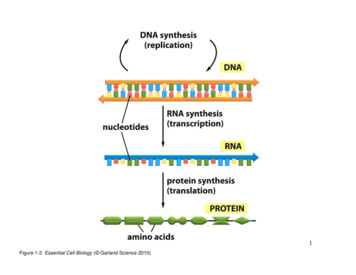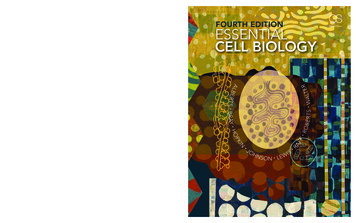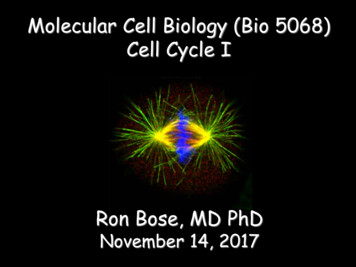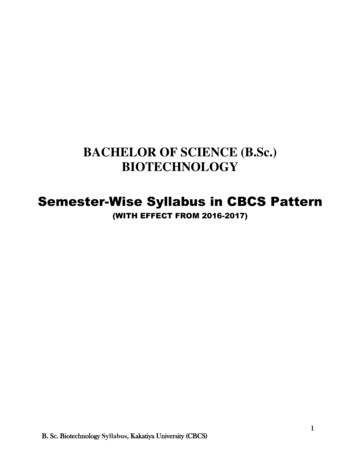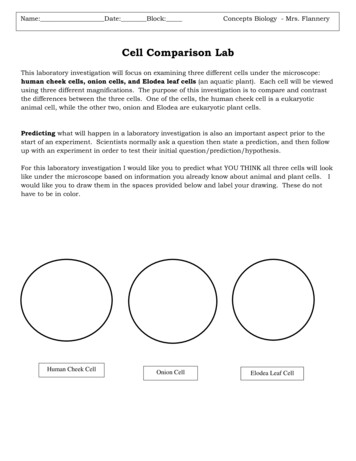
Transcription
Name: Date: Block:Concepts Biology - Mrs. FlanneryCell Comparison LabThis laboratory investigation will focus on examining three different cells under the microscope:human cheek cells, onion cells, and Elodea leaf cells (an aquatic plant). Each cell will be viewedusing three different magnifications. The purpose of this investigation is to compare and contrastthe differences between the three cells. One of the cells, the human cheek cell is a eukaryoticanimal cell, while the other two, onion and Elodea are eukaryotic plant cells.Predicting what will happen in a laboratory investigation is also an important aspect prior to thestart of an experiment. Scientists normally ask a question then state a prediction, and then followup with an experiment in order to test their initial question/prediction/hypothesis.For this laboratory investigation I would like you to predict what YOU THINK all three cells will looklike under the microscope based on information you already know about animal and plant cells. Iwould like you to draw them in the spaces provided below and label your drawing. These do nothave to be in color.Human Cheek CellOnion CellElodea Leaf Cell
MaterialsMicroscopeMicroscope slidesCoverslipsWaterIodineMethylene BlueDroppersToothpicksTweezers/ForcepsOnionElodea LeafProcedureA. Data Collection1. You will be examining three samples under the microscope. For each sample, youmust draw what you see at three magnification powers (40x, 100x, and 400x).2. You will record your data on the data sheet using the circles to draw your samples.B. Examine Human Cheek Cells1. Take a slide and place 1 drop of methylene blue on the center of the slide.2. Take a toothpick and gently scrape the inside of your mouth3. Place the toothpick in the methylene blue on the slide and gently swirl.4. Examine the slide under the microscope at each magnification power (40x, 100x,400x).5. Carefully draw what you see in your field of view on your data sheet.6. Be sure to label all structures and organelles that you can see.C. Examine Onion Cells1. Carefully peel a sheet of onion off of the onion. Be sure that the sheet is as thin aspossible.2. Carefully place the sheet on the center of a microscope slide. Be sure that the sheet ofonion cells is not folded (it must be flat).3. Place one drop of iodine on the sheet of onion cells.4. Place a coverslip over the onion cells.5. Examine the slide under the microscope at each magnification power (40x, 100x,400x).6. Carefully draw what you see in your field of view on your data sheet.7. Be sure to label all structures and organelles that you can see.D. Examine Elodea Leaf Cells1. See me to obtain a single Elodea plant leaf.2. Place the Elodea leaf on a microscope slide.3. Add one drop of water to the Elodea leaf.4. Place a coverslip over the Elodea leaf.5. Examine the slide under the microscope at each magnification power (40x, 100x,400x).6. Carefully draw what you see in your field of view on your data sheet.7. Be sure to label all structures and organelles that you can see.
Name: Date: Block:Biology – Mrs. FlanneryCell Comparison Lab Data SheetHuman Cheek CellsMagnification PowerMagnification PowerMagnification PowerOnion CellsMagnification PowerMagnification PowerElodea Leaf CellMagnification Power
Elodia Leaf CellsMagnification PowerMagnification PowerMagnification PowerResults/DataYour results/data for this lab will consist of the nine drawings you made of the images you sawunder the microscope. Be sure that ALL of your drawings include the following: Appropriate color (not optional) Image magnification is listed. All visible cell structures are labeled.Analysis Questions: These questions must be answered using complete sentences!! TTQAEach Question is worth 4 points.1.Look at your prediction for the human cheek cells.a. Was your prediction (drawing) accurate or inaccurate? Explain.b. Did you draw more structures than you could see?c. Why do you think that only the cell membrane and the nucleus were visible?d. Are the other organelles present or do your cheek cells only contain a nucleus and cellmembrane? Explain your answer.
2. What was the major difference between Elodea leaves and onion cells?3. Why do you think that onion cells do not contain chloroplasts?4. If you look at an elodea leaf with the naked eye it appears solid green.a. Are the elodea leaf cells solid green?b. What gives an elodea leaf its green color?c. Why can’t our eyes see the spaces between chloroplasts?
Cell Comparison Lab This laboratory investigation will focus on examining three different cells under the microscope: human cheek cells, onion cells, and Elodea leaf cells (an aquatic plant). Each cell will be viewed using three different magnifications. The purpose of this investigation is to compare and contrast



